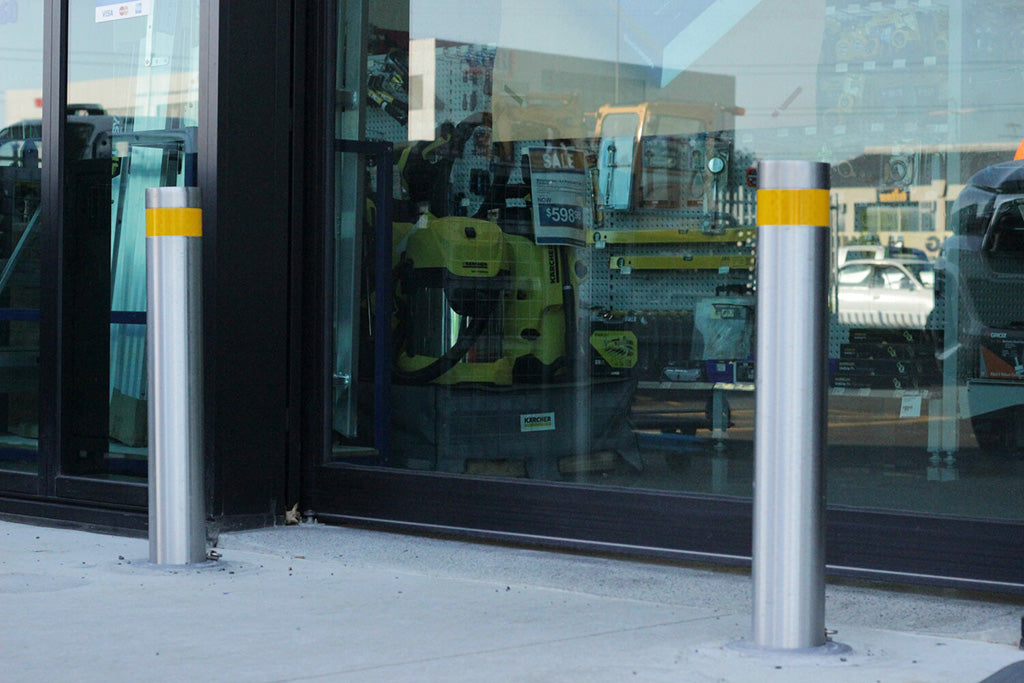Building owners and tenants are busily finding ways not to become the next victim of youth crime so there are three measures you should be aware of that could affect compliance.
Installing Bollards outside your building
With the current spate of ram-raids, we are receiving an increasing number of queries from building owners about the process around installing bollards outside their building as protection against a vehicle being used to breach a shop front – an effective tool in reducing the damage and preventing a business from being targeted. These do not require a building consent but do have a few things which need to be considered.
Firstly, you need to own the property on which the bollard is to be located. If your front wall is on the footpath boundary, then you will need to speak to owner – which might be the council or might be the owner of land such as a shopping centre – about permission to install them.
Next, they must not impede on the means of escape from the tenancies. Doors that open outwards must be able to open to a full 90 degrees and whatever door width is present must be preserved through the bollards, or they will need to be placed far enough away from doors to allow users to navigate their way around them once they have left the building. If you have a wide doorset – such as a wide glass frontage, then a removable bollard would be recommended. One able to be removed before trading every day and installed once the tenancy has closed. These can be retractable units that sink into the ground or ones which can be removed from a stable flat footing.
Practically for protection against vehicles, application and material should also be considered. Bolt-down bollards will offer less protection than bollards that are embedded in the ground, but care must be taken when digging to the services which lie underneath such as electrical, data and water pipes.
Timber bollards should be angle cut on the top to avoid water resting on the top and metal bollards should be a corrosive-resistant steel (such as marine-grade 316 stainless) which has been hardened and toughened, and these should also be a contrasting colour to the environment so people with visual impairments (or just clumsy people) can easily avoid running into them. Visible bollards will also act as a deterrent to offenders as crime tends to favour the easy option.
Bollards should be placed apart at 1.5m maximum to limit access through or around by small vehicles, and should be at least 500mm back from a kerb where cars may park. Place them away from water drain points and surface water. Ensure the concrete pad is flush to the ground and a clear path of 1200mm is maintained for disabled access along a footpath or walkway – consider also where footpath signage is installed which can add to the clutter. If using retractable or removable bollards, the cover plates should sit uniformly to create a flat surface.
You can make wider areas safe by installing concrete bollards, fixed seating, cycle stands or heavy planter boxes as well which can provide aesthetic and function in addition to security. Mature trees make great bollards.
If you have questions about the compliance implications of protecting your property with bollards, security grilles or other similar measures, please contact your local council or our building compliance experts and we would be pleased to help.
Fog Canons
Sometimes these are marketed as “Smoke Cloak” systems, which is a good description of the way they work. The system operates a thick fog which deploys quickly making the goods in the premises impossible to see - and therefore to steal.
If you have a Fog Canon this will activate a smoke detector in the area, and the fire alarms will sound if you have smoke detectors on the fire alarm. Please make sure the installer is aware of this and have us attend to isolate the alarms to prevent an evacuation or the fire service turning up unexpectedly. We must also be called when the system is tested.
Fog canons do not require a building consent, but nobody has raised the concept that these will also make evacuation in an emergency difficult if a fog canon has been deployed. It is possible that this may be raised in time./p>
Locking doors
Be aware that installing additional locks on doors is likely to become a compliance issue. The building Code does not permit key locks to be fitted on exit doors where someone lawfully occupying the building could be prevented from leaving, but you can fit a security bolt to the outside your main entry which is unlocked before the building is occupied, and the bolt is by design secured into the unlocked position. Speak to a good locksmith about the options before you fit anything which might jeopardise your warrant of fitness.

